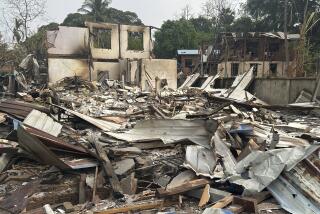Fierce fighting roils city ‘liberated’ by Kadafi troops
- Share via
Reporting from Misurata, Libya — Government loyalists tried to show Monday that they had wrested control of the last major rebel-held enclave in western Libya, but a visit only underscored that ferocious fighting continued in the city.
It also showed how deeply Libyan leader Moammar Kadafi’s forces were embedded within the heart of Misurata and how difficult it would be to dislodge them without risking civilian lives.
Libyan officials hustled international journalists onto a pair of buses Monday afternoon in Tripoli for a trip to what government spokesman Musa Ibrahim described as “liberated” Misurata, about 125 miles to the east.
Photos: Libyan rebels on front line in Bin Jawwad
Reporters were briefly taken to one location just inside the jittery, war-damaged city where plumes of smoke rose in the distance and automatic-weapons fire rattled continuously as dusk approached. A few dozen Kadafi supporters, including children, who had been shuttled in from outside the city in police pickup trucks were presented as Misurata residents.
Otherwise the streets were an abandoned, battle-scorched wasteland of broken glass and the detritus of warfare.
But the state news agency declared, “The city of Misurata is now enjoying security and calm and the city’s public installations have started regaining their ability to offer the usual services to all citizens.”
Misurata, a city of more than 600,000 people, lies between Tripoli, the capital, and the Kadafi stronghold of Surt. It was listed by President Obama as one of the cities that Kadafi must refrain from attacking before a multinational coalition would consider halting airstrikes and lifting a U.N.-sanctioned no-fly zone over Libya.
It was unclear whether the Kadafi government had taken new territory in the city or was merely attempting to distract media attention as rebels advance on Surt, the Libyan leader’s birthplace and last major roadblock in the opposition’s march toward Tripoli.
Rebels still in control in parts of Misurata have long acknowledged that gunmen loyal to Kadafi have maintained a seesawing presence on Tripoli Street, which leads from the country’s coastal highway to the city center. But one resident of Libya’s third-largest city said government forces control about 70% of the street and have placed gunmen on key buildings to terrorize residents.
The rebels also have said that Kadafi’s troops control the entrances to Misurata. But even on the outskirts of the city, there was evidence Monday of ferocious fighting between loyalists and rebels, who have formed an interim city government loyal to the opposition’s transitional government, based in the eastern city of Benghazi.
Checkpoints manned by the armed forces lined the largely rural coastal highway between Tripoli and Misurata. Tensions flared at one of the many lines for gasoline as authorities pulled passengers from a minibus. The burned carcasses of military vehicles littered the roadside. The once-ubiquitous portraits of Kadafi had been torn down. Shops along the route were mostly shuttered.
As Misurata approached, the scenes of intense warfare were clear. Along the commercial strip to the south of the coastal highway, spent bullet casings and the shredded remains of more military vehicles littered the road. Nearly every building was pockmarked with bullet holes from small arms or high-caliber weapons; many sites showed evidence of tank fire.
Several shops appeared to have been completely looted, and the only people visible were soldiers or Kadafi militiamen. In the distance was an ammunition depot apparently struck by coalition airstrikes Sunday.
The convoy of visiting journalists eventually stopped just inside the city, about a mile and a half from the central square. A state television satellite truck was waiting. Pickup trucks and cars full of children and Kadafi supporters began chanting in support of the leader and waving green flags.
A corner office building had been badly torn apart by gunfire. Many of the buildings bore signs of tank fire from the south, suggesting Kadafi’s troops had fired on the buildings as they forced their way past rebels into the city.
Gunmen could be seen on rooftops along the street. As the journalists stepped off the bus, the sounds of automatic-weapons fire could be heard getting louder and more intense. It was a sign, one soldier said, that opposition supporters were attacking.
“They’re not Libyans,” said one soldier wearing a bulletproof vest, neck guard and helmet. “They’re Afghans, Egyptians.”
Not 10 minutes after the buses arrived, as the fighting appeared to intensify, soldiers began to push the journalists back onto the vehicles and out of the city. At night “the French will start bombing,” said one soldier, although there was no evidence that coalition airstrikes had struck the city Monday.
As the buses pulled out, the unruly group described as Misurata residents could be seen quickly piling into cars and police trucks, racing ahead of the journalists in the direction of Tripoli.
More to Read
Sign up for Essential California
The most important California stories and recommendations in your inbox every morning.
You may occasionally receive promotional content from the Los Angeles Times.










